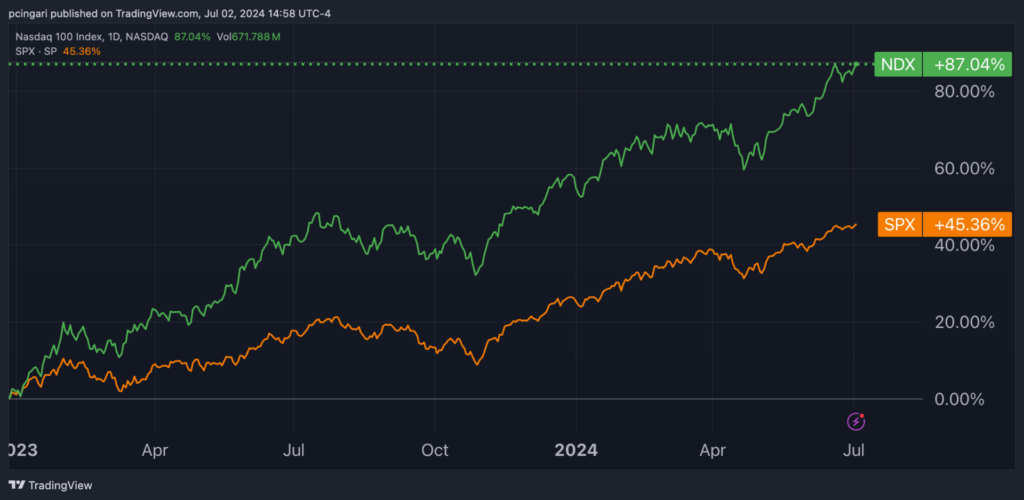Zinger Key Points
- Goldman Sachs’ Peter Oppenheimer highlights global stocks face high valuations and political risks, which may dampen FOMO after a rally.
- Global equities haven’t seen a 5% pullback since last year's correction, showcasing potential vulnerability ahead.
- China’s new tariffs just reignited the same market patterns that led to triple- and quadruple-digit wins for Matt Maley. Get the next trade alert free.
The U.S. stock market enjoyed an impressive performance throughout the first half of the year — the 21st best since 1900.
As we move into the second half of 2024, equity investors face greater risks, according to a Goldman Sachs note issued Tuesday.
Below are 10 reasons why equity analyst Peter Oppenheimer feels that global stocks are navigating an unusual environment characterized by high valuations and increased political tension. This could diminish the fear of missing out (FOMO) after a significant rally.
Chart: Nasdaq 100, S&P 500 Have Rallied 87% And 45%, Respectively Since Late 2022

- Resilience Without Pullbacks: “We haven’t seen a 5% pullback in global equities since the correction in the second half of last year,” said Oppenheimer, highlighting the remarkable resilience of equity markets worldwide.
- Limited Buffers: Historically, strong returns in the first half are not followed by weak returns in the second half. The last instance of a negative second half after a 15% gain in the first half was in 1986. This pattern has occurred only seven times since 1900. “Equity risk premia have fallen sharply, offering little buffer against bonds in the event of shocks,” Oppenheimer said.
- Slowing Growth Momentum: While optimism about interest rates has been offset by strong growth and earnings, this momentum is slowing. Macro surprises have turned negative across regions, with weaker US housing data and European PMIs. U.S. GDP growth has decelerated from 4.1% in H2 2023 to an estimated 1.7% in H1 2024, and unemployment has ticked up from 3.5% to 3.8%. This period of weaker growth is likely to continue, according to Goldman Sachs, as real income growth slows and consumer sentiment declines, exacerbated by upcoming elections in the U.S. and Europe.
- Elevated Valuations: High valuations leave equities more susceptible to disappointments. Goldman Sachs stressed that the market capitalization of the S&P 500 has diverged significantly from other markets since the financial crisis.
- Market Concentration Risks: “The top 7 companies have contributed to over 60% of the return in the S&P 500 year to date,” Oppenheimer said, adding that “the degree of stock concentration is extreme” in the S&P 500 as the largest 10 stocks have the highest share since 1929.
- AI-Related Capex Concerns: Recent concerns about the AI-related capital expenditure boom have emerged. Micron Technology Inc. (NASDAQ: MU=’s recent performance and Nvidia Corp. (NASDAQ: NVDA) 's stock volatility reflect this anxiety. With ChatGPT usage declining from 2 billion visits per month to around 600 million currently, there is growing scrutiny on company outlooks related to AI.
- Increased Risk Positioning: This quarter’s earnings focus is heightened by increased risk positioning. Hedge funds and mutual funds have raised their equity exposures, with hedge fund net leverage nearing its highest level in the past year and mutual fund cash balances hitting record lows.
- Political Risks: “Politics is becoming a central focus,” according to Oppenheimer. Earlier this year, elections were seen as a ‘known unknown,' with significant global voter turnout anticipated but little impact on market pricing so far.
- Government Debt Focus: Election focus has also heightened attention on government borrowing and debt. Rising debt levels in developed and emerging economies remain a critical issue, with no clear political solutions in sight.
- Higher Volatility Risk: The risk of higher volatility or a correction is evident in fundamental indicators. Goldman Sachs’ Bull/Bear indicator is flashing red. While this doesn’t indicate an imminent bear market, it suggests a higher likelihood of corrections and increased volatility in the near future.
Now Read:
Image: Shutterstock
Edge Rankings
Price Trend
© 2025 Benzinga.com. Benzinga does not provide investment advice. All rights reserved.
Trade confidently with insights and alerts from analyst ratings, free reports and breaking news that affects the stocks you care about.